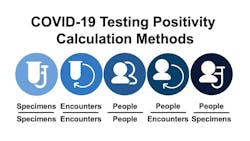Lack of test positivity standards for COVID-19 demands recalculation
Due to the evolving and challenging pandemic data landscape and persisting incomplete data streams, the Coronavirus Resource Center has redefined and expanded how it calculates COVID-19 positivity for U.S. states. This effort is required due to the lack of federal standards and a perplexing testing data environment.
The Coronavirus Resource Center (CRC) has released sweeping changes to how we calculate and report COVID-19 testing positivity. Test positivity (a percentage indicating the frequency of positive cases) is not a measure of disease presence in an area, but instead, a metric for understanding testing capacity.
Previously, the CRC reported positivity by dividing the number of cases by the total number of test results. Depending on the state, “results” could have referred to tests, testing encounters, or specimens. This initial approach was selected because it permitted a “person-centric” positivity ratio to be calculated for all states, or a ratio that focused on people infected rather than tests conducted. The use of “results” as the denominator meant no state was excluded based on the type of testing data it provided.
A new Positivity Calculation Hierarchy developed at the CRC allows multiple methods to be used to analyze data depending on the information each state provides. There are multiple acceptable methods to calculate positivity with varying utility. Our design principles were simple: unit consistency, use of specimens as opposed to people tested, and near equivalency of encounters and specimens.
Consistency between units in the numerator and denominator of a proportion is standard operating procedure across fields because the result is a unitless percentage that can be applied to a wider population in ideal conditions. For example, when comparing colleges based on graduation rates, you examine the percentage of students that graduate out of all the enrolled students at each institution. The percentage of all graduating students in relation to the number of STEM majors is much less informative to the decision-making process. In the same vein, we want to compare “specimens” to “specimens” and “people tested” to “people tested” whenever possible – these calculations are used in the first three methods of the new hierarchy.
The CDC maintains the central repository of national public health data, but its collection is incomplete because states are not required to submit their data. In addition, the CDC does not impose one standard method for calculating positivity. Absent a universal dataset, we have no way of comparing states. Despite the revamping of positivity on the Coronavirus Resource Center, there is not a single calculation method for which all states provide the appropriate data. The lack of complete federal data can also lead to confusion among citizens, localities, states, and the federal government.
With inconsistent naming and changing definitions for example, when is a COVID case a COVID case? Does a person have to have symptoms? Do they need to get tested once they are already hospitalized?
In order to determine and report a confirmed positive person, we need to know what a positive person really is. That, too, varies from state to state and has changed throughout the pandemic. This issue has been repeated with breakthrough cases, reinfections, and asymptomatic cases.
Identifying the difference between “specimens” and “encounters” in each state has been a source of confusion even for those of us at the CRC who wade into this data every day.
In general we utilize the definitions originally set by the COVID Tracking Project: “specimens” refer to total samples collected and “encounters” refer to the number of people tested in one reporting period regardless of how often they were tested during that time. The conversion from “specimens” to “encounters” is through deduplication, which the COVID Tracking Project originally assigned a standard time frame of one day. But the deduplication window is defined differently across states. We need a standard data dictionary from which all states can work.
